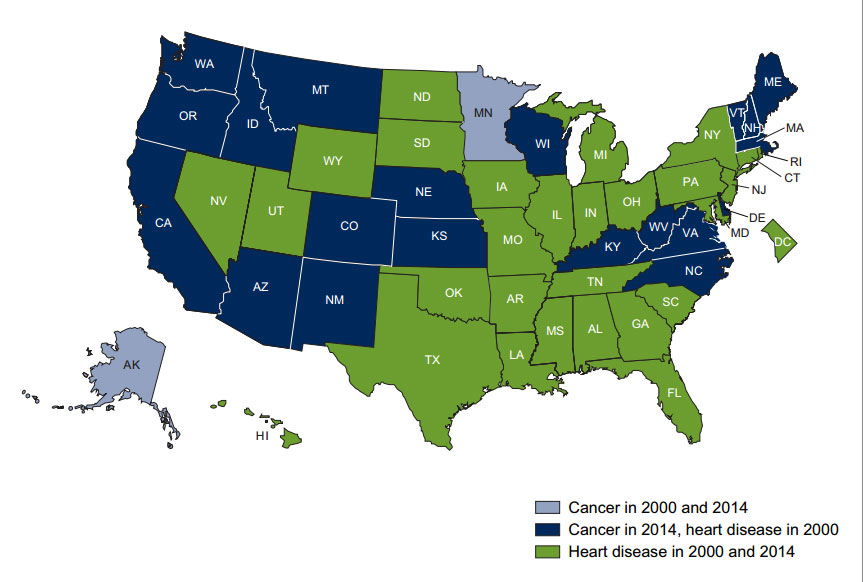America's No. 1 Killer Is Changing

Cancer has passed heart disease as the leading cause of death in nearly half of U.S. states, according to a new report.
In 2014, cancer was the leading cause of death in 22 states, including many in the West and Northeast. That's a jump from the year 2000, when cancer was the leading cause of death in just two states.
In the rest of the 28 states, heart disease remained the leading cause of death in 2014. And in the U.S. population as a whole, heart disease deaths still outnumber cancer deaths: There were 614,348 people who died from heart disease in 2014, compared to 591,699 who died from cancer, according to the report, from the Centers for Disease Control and Prevention (CDC).
Still, the new report shows that deaths from cancer have nearly caught up with deaths from heart disease over the last several decades in the United States. That's both because deaths from heart disease have declined in recent decades and because deaths from cancer have continued to tick upward.
For example, in 1985, more than 770,000 people died from heart disease in the U.S., compared to about 450,000 from cancer. But by 2011, that gap had narrowed; during that year, there were 596,577 deaths from heart disease and 576,691 from cancer, the report said. [Top 10 Leading Causes of Death]
The new report "highlights the great strides that the cardiovascular community has [made]," in educating people about risk factors for heart disease, said Dr. Laxmi Mehta, director of the Women’s Cardiovascular Health Program at The Ohio State University Wexner Medical Center, who was not involved in the report. [Map: Causes of Death in the U.S.]
This education led to a reduction in risk factors for heart disease, such as smoking, Mehta said. It's also helped people better understand the symptoms of heart disease, leading to earlier diagnosis of the condition. And doctors have improved the way they treat heart attacks, leading to a reduction in death rates from heart attack complications, she said.
Get the world’s most fascinating discoveries delivered straight to your inbox.
In contrast, some cancers remain hard to catch in the early stages, Mehta said. And even though heart disease and cancer share many of the same risk factors, a person's genes may play a larger role in the development of some cancers, making the disease harder to tackle using preventive steps compared with heart disease, Mehta said.
But the new findings don't mean people can become complacent about heart disease. Although cancer deaths were on course to surpass heart disease deaths by the early 2010s, this didn't happen. That's because, from 2011 to 2014, heart disease deaths increased slightly more than cancer deaths, keeping heart disease at the top of the rankings overall.
Mehta noted that obesity rates and inactivity among children are on the rise, which could contribute to an increase in heart disease deaths in decades to come.
"The last thing we want is people to think, 'I don’t have to worry about heart disease anymore,'" Mehta said. "Even if cancer surpasses heart disease now ... in the future there's potential for it coming back," she said.
The new report is published today (Aug. 24) by the CDC's National Center for Health Statistics.
Original article on Live Science.

Rachael is a Live Science contributor, and was a former channel editor and senior writer for Live Science between 2010 and 2022. She has a master's degree in journalism from New York University's Science, Health and Environmental Reporting Program. She also holds a B.S. in molecular biology and an M.S. in biology from the University of California, San Diego. Her work has appeared in Scienceline, The Washington Post and Scientific American.




